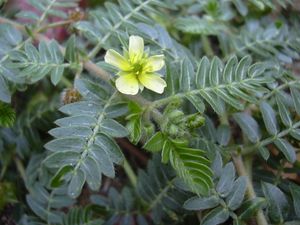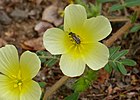Note: This is a project under development. The articles on this wiki are just being initiated and broadly incomplete. You can Help creating new pages.
Difference between revisions of "Tribulus terrestris - Gokshura"
(→External Links) |
|||
| (11 intermediate revisions by 2 users not shown) | |||
| Line 1: | Line 1: | ||
[[File:Starr 030612-0063 Tribulus terrestris.jpg|thumb|right|''Gokshura'', ''Tribulus terrestris'', ''Small Caltrops'']] | [[File:Starr 030612-0063 Tribulus terrestris.jpg|thumb|right|''Gokshura'', ''Tribulus terrestris'', ''Small Caltrops'']] | ||
| − | + | '''Tribulus terrestris''' is an annual plant in the caltrop family. It is widely distributed around the world, that is adapted to grow in dry climate locations in which few other plants can survive. | |
| − | '''Tribulus terrestris''' is an annual plant in the caltrop family | ||
| − | |||
==Uses== | ==Uses== | ||
{{Uses|Impotency}}, {{Uses|Painful urination}}, {{Uses|Kidney diseases}}, {{Uses|Gout diseases}}, {{Uses|Cancer}}, {{Uses|Blotches}}, {{Uses|Pimples}}, {{Uses|Leprosy}}, {{Uses|Skin diseases}}, {{Uses|Psoriasis}}, {{Uses|Congestion}}. | {{Uses|Impotency}}, {{Uses|Painful urination}}, {{Uses|Kidney diseases}}, {{Uses|Gout diseases}}, {{Uses|Cancer}}, {{Uses|Blotches}}, {{Uses|Pimples}}, {{Uses|Leprosy}}, {{Uses|Skin diseases}}, {{Uses|Psoriasis}}, {{Uses|Congestion}}. | ||
| + | |||
| + | ===Food=== | ||
| + | Tribulus terrestris can be used in Food. Young leaves and tender fruits are cooked as vegetable.<ref name="Forest foods of Western Ghat"/> | ||
==Parts Used== | ==Parts Used== | ||
| Line 13: | Line 14: | ||
==Common names== | ==Common names== | ||
| − | {{Common names|kn=|ml= Nerinnii|sa=|ta=Palleru-mullu|te=Cinnpalleru|hi=Gokharu |en=Puncture Vine, Caltrop}} | + | {{Common names|kn=ನೆಗ್ಗಿಲು Neggilu, ನೆರಿಗಿಲು Nerigilu|ml=Nerinnii|sa=Ashvadanshtra|ta=Palleru-mullu|te=Cinnpalleru|hi=Gokharu|en=Puncture Vine, Caltrop}}<ref name="Common names"/> |
==Properties== | ==Properties== | ||
| Line 30: | Line 31: | ||
Kapha, Vata | Kapha, Vata | ||
===Prabhava=== | ===Prabhava=== | ||
| + | |||
| + | ===Nutritional components=== | ||
| + | Tribulus terrestris Contains the Following nutritional components like - Vitamin-A, B and C; Alkaloides; Tannins; Phenols; Flavonoides; Flavonal glycosides; Steroidal saponins; Calcium, Copper, Iron, Magnesium, Manganese, Phosphorus, Potassium, Sulphur, Zinc<ref name="Forest foods of Western Ghat"/> | ||
==Habit== | ==Habit== | ||
| Line 36: | Line 40: | ||
==Identification== | ==Identification== | ||
===Leaf=== | ===Leaf=== | ||
| − | {{Leaf|Simple||The leaves are pinnately compound with leaflets less than a quarter-inch long}}<ref name="Leaf"/> | + | {{Leaf|Simple|Pinnate|The leaves are pinnately compound with leaflets less than a quarter-inch long}}<ref name="Leaf"/> |
===Flower=== | ===Flower=== | ||
| Line 42: | Line 46: | ||
===Fruit=== | ===Fruit=== | ||
| − | {{Fruit||10 mm longe| | + | {{Fruit||10 mm longe|Fruit is easily falls apart into four or five single-seeded nutlets||5|Fruiting season is April to August}} |
===Other features=== | ===Other features=== | ||
==List of Ayurvedic medicine in which the herb is used== | ==List of Ayurvedic medicine in which the herb is used== | ||
| − | * [[ | + | * [[Gokshuradi churna]] |
| + | * [[Gokshuradi guggulu]] | ||
| + | * [[Dashamoolarishta]] | ||
| + | <ref name="Ayurvedic preparations"/> | ||
==Where to get the saplings== | ==Where to get the saplings== | ||
| Line 54: | Line 61: | ||
==How to plant/cultivate== | ==How to plant/cultivate== | ||
| − | We have very little information on this species and are not sure how successful it will be in Britain | + | We have very little information on this species and are not sure how successful it will be in Britain<ref name="How to plant/cultivate"/>. Tribulus terrestris is available throughout the year<ref name="chemical composition"/>. |
==Commonly seen growing in areas== | ==Commonly seen growing in areas== | ||
| Line 75: | Line 82: | ||
<references> | <references> | ||
| − | <ref name="chemical composition">[https://www.mdidea.com/products/herbextract/tribulus/data05.html | + | <ref name="chemical composition">[https://www.mdidea.com/products/herbextract/tribulus/data05.html Chemical constituents]</ref> |
| − | <ref name="Leaf">[ | + | <ref name="Leaf">Kappatagudda - A Repertoire of Medicianal Plants of Gadag by Yashpal Kshirasagar and Sonal Vrishni, Page No. 374 |
| + | </ref> | ||
| + | <ref name="Common names">[https://sites.google.com/site/indiannamesofplants/via-species/t/tribulus-terrestris Common names]</ref> | ||
| − | <ref name="How to plant/cultivate">[https://pfaf.org/user/Plant.aspx?LatinName=Tribulus+terrestrisia | + | <ref name="How to plant/cultivate">[https://pfaf.org/user/Plant.aspx?LatinName=Tribulus+terrestrisia Cultivation details]</ref> |
| + | <ref name="Ayurvedic preparations">[https://easyayurveda.com/2012/10/19/tribulus-benefits-dosage-side-effects-medicines-ayurvedic-details/ Ayurvedic preparations]</ref> | ||
| + | <ref name="Forest foods of Western Ghat">"Forest food for Northern region of Western Ghats" by Dr. Mandar N. Datar and Dr. Anuradha S. Upadhye, Page No.148, Published by Maharashtra Association for the Cultivation of Science (MACS) Agharkar Research Institute, Gopal Ganesh Agarkar Road, Pune</ref> | ||
</references> | </references> | ||
| Line 88: | Line 99: | ||
[[Category:Herbs]] | [[Category:Herbs]] | ||
| + | [[Category:Zygophyllaceae]] | ||
Latest revision as of 15:57, 17 November 2021
Tribulus terrestris is an annual plant in the caltrop family. It is widely distributed around the world, that is adapted to grow in dry climate locations in which few other plants can survive.
Contents
- 1 Uses
- 2 Parts Used
- 3 Chemical Composition
- 4 Common names
- 5 Properties
- 6 Habit
- 7 Identification
- 8 List of Ayurvedic medicine in which the herb is used
- 9 Where to get the saplings
- 10 Mode of Propagation
- 11 How to plant/cultivate
- 12 Commonly seen growing in areas
- 13 Photo Gallery
- 14 References
- 15 External Links
Uses
Impotency, Painful urination, Kidney diseases, Gout diseases, Cancer, Blotches, Pimples, Leprosy, Skin diseases, Psoriasis, Congestion.
Food
Tribulus terrestris can be used in Food. Young leaves and tender fruits are cooked as vegetable.[1]
Parts Used
Chemical Composition
Sterols such as beta-sitosterols or stigma. These chemical compounds help to protect the prostate gland from swelling and in combination with the X steroidal saponins, may help to protect the prostate from cancer.[2]
Common names
| Language | Common name |
|---|---|
| Kannada | ನೆಗ್ಗಿಲು Neggilu, ನೆರಿಗಿಲು Nerigilu |
| Hindi | Gokharu |
| Malayalam | Nerinnii |
| Tamil | Palleru-mullu |
| Telugu | Cinnpalleru |
| Marathi | NA |
| Gujarathi | NA |
| Punjabi | NA |
| Kashmiri | NA |
| Sanskrit | Ashvadanshtra |
| English | Puncture Vine, Caltrop |
Properties
Reference: Dravya - Substance, Rasa - Taste, Guna - Qualities, Veerya - Potency, Vipaka - Post-digesion effect, Karma - Pharmacological activity, Prabhava - Therepeutics.
Dravya
Rasa
Tikta (Bitter), Kashaya (Astringent)
Guna
Laghu (Light), Ruksha (Dry), Tikshna (Sharp)
Veerya
Ushna (Hot)
Vipaka
Katu (Pungent)
Karma
Kapha, Vata
Prabhava
Nutritional components
Tribulus terrestris Contains the Following nutritional components like - Vitamin-A, B and C; Alkaloides; Tannins; Phenols; Flavonoides; Flavonal glycosides; Steroidal saponins; Calcium, Copper, Iron, Magnesium, Manganese, Phosphorus, Potassium, Sulphur, Zinc[1]
Habit
Identification
Leaf
| Kind | Shape | Feature |
|---|---|---|
| Simple | Pinnate | The leaves are pinnately compound with leaflets less than a quarter-inch long |
Flower
| Type | Size | Color and composition | Stamen | More information |
|---|---|---|---|---|
| Unisexual | 4-10 mm wide | Yellow | 5-20 | The flowers are 4-10 mm wide, with five lemon-yellow petals. A week after each flower blooms |
Fruit
| Type | Size | Mass | Appearance | Seeds | More information |
|---|---|---|---|---|---|
| 10 mm longe | Fruit is easily falls apart into four or five single-seeded nutlets | 5 | Fruiting season is April to August |
Other features
List of Ayurvedic medicine in which the herb is used
Where to get the saplings
Mode of Propagation
How to plant/cultivate
We have very little information on this species and are not sure how successful it will be in Britain[6]. Tribulus terrestris is available throughout the year[2].
Commonly seen growing in areas
Tall grasslands, Weed in Europe, Sandy seashores in Japan.
Photo Gallery
References
- ↑ 1.0 1.1 "Forest food for Northern region of Western Ghats" by Dr. Mandar N. Datar and Dr. Anuradha S. Upadhye, Page No.148, Published by Maharashtra Association for the Cultivation of Science (MACS) Agharkar Research Institute, Gopal Ganesh Agarkar Road, Pune
- ↑ 2.0 2.1 Chemical constituents
- ↑ Common names
- ↑ Kappatagudda - A Repertoire of Medicianal Plants of Gadag by Yashpal Kshirasagar and Sonal Vrishni, Page No. 374
- ↑ Ayurvedic preparations
- ↑ Cultivation details
External Links
- Ayurvedic Herbs known to be helpful to treat Impotency
- Ayurvedic Herbs known to be helpful to treat Painful urination
- Ayurvedic Herbs known to be helpful to treat Kidney diseases
- Ayurvedic Herbs known to be helpful to treat Gout diseases
- Ayurvedic Herbs known to be helpful to treat Cancer
- Ayurvedic Herbs known to be helpful to treat Blotches
- Ayurvedic Herbs known to be helpful to treat Pimples
- Ayurvedic Herbs known to be helpful to treat Leprosy
- Ayurvedic Herbs known to be helpful to treat Skin diseases
- Ayurvedic Herbs known to be helpful to treat Psoriasis
- Ayurvedic Herbs known to be helpful to treat Congestion
- Herbs with Fruits used in medicine
- Herbs with Leaves used in medicine
- Herbs with common name in Kannada
- Herbs with common name in Hindi
- Herbs with common name in Malayalam
- Herbs with common name in Tamil
- Herbs with common name in Telugu
- Herbs with common name in Sanskrit
- Herbs with common name in English
- Habit - Herb
- Index of Plants which can be propagated by Seeds
- Index of Plants which can be propagated by Cuttings
- Herbs that are commonly seen in the region of Tall grasslands
- Herbs that are commonly seen in the region of Weed in Europe
- Herbs that are commonly seen in the region of Sandy seashores in Japan
- Herbs
- Zygophyllaceae






